Determinants of Physical Activity and Sedentary Behaviour in University Students
VerifiedAdded on 2023/01/17
|5
|1066
|55
AI Summary
This research article explores the determinants of physical activity and sedentary behaviour in university students. It discusses the impact of individual, social, and environmental factors on student behavior and suggests interventions to promote healthy habits.
Contribute Materials
Your contribution can guide someone’s learning journey. Share your
documents today.
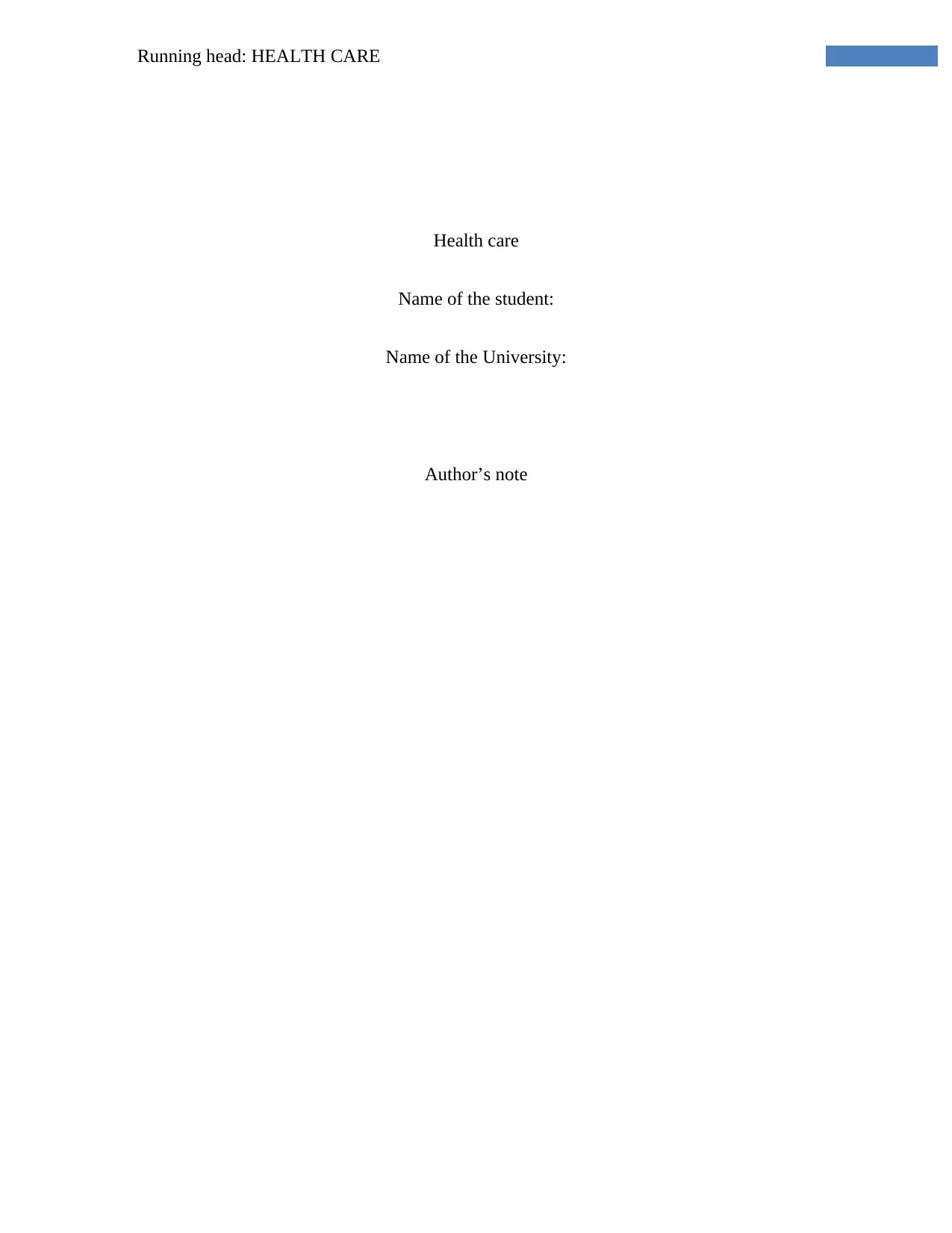
Running head: HEALTH CARE
Health care
Name of the student:
Name of the University:
Author’s note
Health care
Name of the student:
Name of the University:
Author’s note
Secure Best Marks with AI Grader
Need help grading? Try our AI Grader for instant feedback on your assignments.
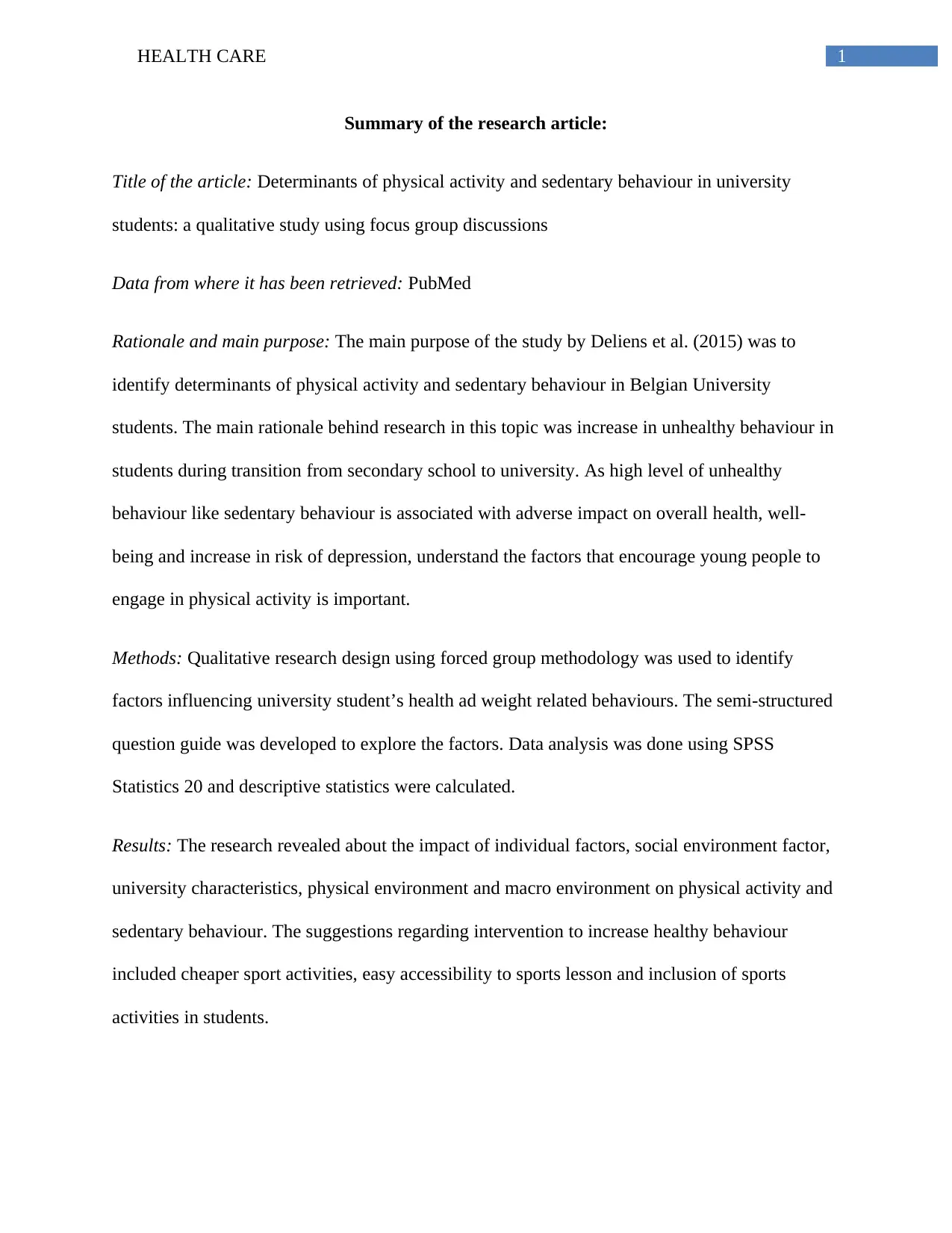
1HEALTH CARE
Summary of the research article:
Title of the article: Determinants of physical activity and sedentary behaviour in university
students: a qualitative study using focus group discussions
Data from where it has been retrieved: PubMed
Rationale and main purpose: The main purpose of the study by Deliens et al. (2015) was to
identify determinants of physical activity and sedentary behaviour in Belgian University
students. The main rationale behind research in this topic was increase in unhealthy behaviour in
students during transition from secondary school to university. As high level of unhealthy
behaviour like sedentary behaviour is associated with adverse impact on overall health, well-
being and increase in risk of depression, understand the factors that encourage young people to
engage in physical activity is important.
Methods: Qualitative research design using forced group methodology was used to identify
factors influencing university student’s health ad weight related behaviours. The semi-structured
question guide was developed to explore the factors. Data analysis was done using SPSS
Statistics 20 and descriptive statistics were calculated.
Results: The research revealed about the impact of individual factors, social environment factor,
university characteristics, physical environment and macro environment on physical activity and
sedentary behaviour. The suggestions regarding intervention to increase healthy behaviour
included cheaper sport activities, easy accessibility to sports lesson and inclusion of sports
activities in students.
Summary of the research article:
Title of the article: Determinants of physical activity and sedentary behaviour in university
students: a qualitative study using focus group discussions
Data from where it has been retrieved: PubMed
Rationale and main purpose: The main purpose of the study by Deliens et al. (2015) was to
identify determinants of physical activity and sedentary behaviour in Belgian University
students. The main rationale behind research in this topic was increase in unhealthy behaviour in
students during transition from secondary school to university. As high level of unhealthy
behaviour like sedentary behaviour is associated with adverse impact on overall health, well-
being and increase in risk of depression, understand the factors that encourage young people to
engage in physical activity is important.
Methods: Qualitative research design using forced group methodology was used to identify
factors influencing university student’s health ad weight related behaviours. The semi-structured
question guide was developed to explore the factors. Data analysis was done using SPSS
Statistics 20 and descriptive statistics were calculated.
Results: The research revealed about the impact of individual factors, social environment factor,
university characteristics, physical environment and macro environment on physical activity and
sedentary behaviour. The suggestions regarding intervention to increase healthy behaviour
included cheaper sport activities, easy accessibility to sports lesson and inclusion of sports
activities in students.
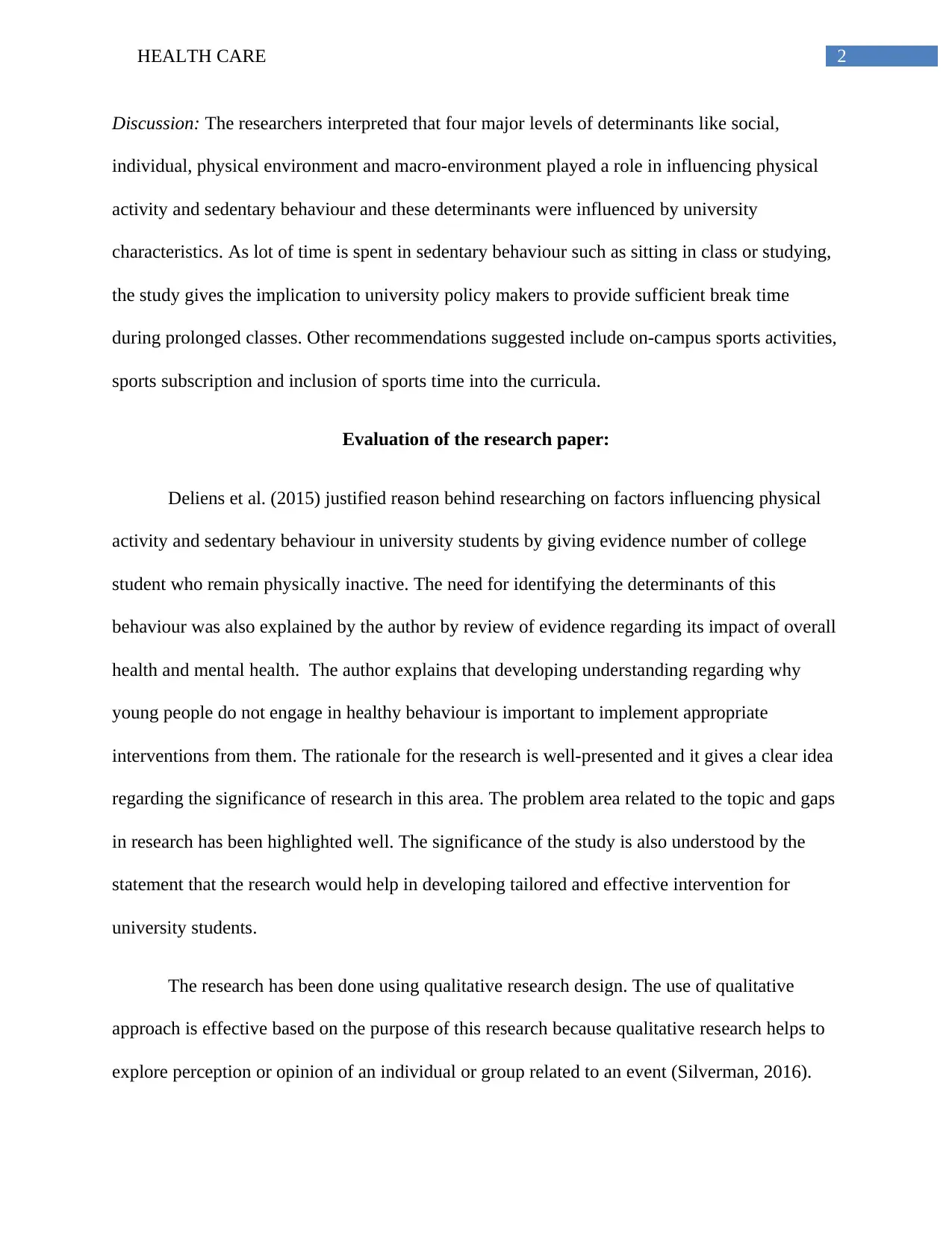
2HEALTH CARE
Discussion: The researchers interpreted that four major levels of determinants like social,
individual, physical environment and macro-environment played a role in influencing physical
activity and sedentary behaviour and these determinants were influenced by university
characteristics. As lot of time is spent in sedentary behaviour such as sitting in class or studying,
the study gives the implication to university policy makers to provide sufficient break time
during prolonged classes. Other recommendations suggested include on-campus sports activities,
sports subscription and inclusion of sports time into the curricula.
Evaluation of the research paper:
Deliens et al. (2015) justified reason behind researching on factors influencing physical
activity and sedentary behaviour in university students by giving evidence number of college
student who remain physically inactive. The need for identifying the determinants of this
behaviour was also explained by the author by review of evidence regarding its impact of overall
health and mental health. The author explains that developing understanding regarding why
young people do not engage in healthy behaviour is important to implement appropriate
interventions from them. The rationale for the research is well-presented and it gives a clear idea
regarding the significance of research in this area. The problem area related to the topic and gaps
in research has been highlighted well. The significance of the study is also understood by the
statement that the research would help in developing tailored and effective intervention for
university students.
The research has been done using qualitative research design. The use of qualitative
approach is effective based on the purpose of this research because qualitative research helps to
explore perception or opinion of an individual or group related to an event (Silverman, 2016).
Discussion: The researchers interpreted that four major levels of determinants like social,
individual, physical environment and macro-environment played a role in influencing physical
activity and sedentary behaviour and these determinants were influenced by university
characteristics. As lot of time is spent in sedentary behaviour such as sitting in class or studying,
the study gives the implication to university policy makers to provide sufficient break time
during prolonged classes. Other recommendations suggested include on-campus sports activities,
sports subscription and inclusion of sports time into the curricula.
Evaluation of the research paper:
Deliens et al. (2015) justified reason behind researching on factors influencing physical
activity and sedentary behaviour in university students by giving evidence number of college
student who remain physically inactive. The need for identifying the determinants of this
behaviour was also explained by the author by review of evidence regarding its impact of overall
health and mental health. The author explains that developing understanding regarding why
young people do not engage in healthy behaviour is important to implement appropriate
interventions from them. The rationale for the research is well-presented and it gives a clear idea
regarding the significance of research in this area. The problem area related to the topic and gaps
in research has been highlighted well. The significance of the study is also understood by the
statement that the research would help in developing tailored and effective intervention for
university students.
The research has been done using qualitative research design. The use of qualitative
approach is effective based on the purpose of this research because qualitative research helps to
explore perception or opinion of an individual or group related to an event (Silverman, 2016).
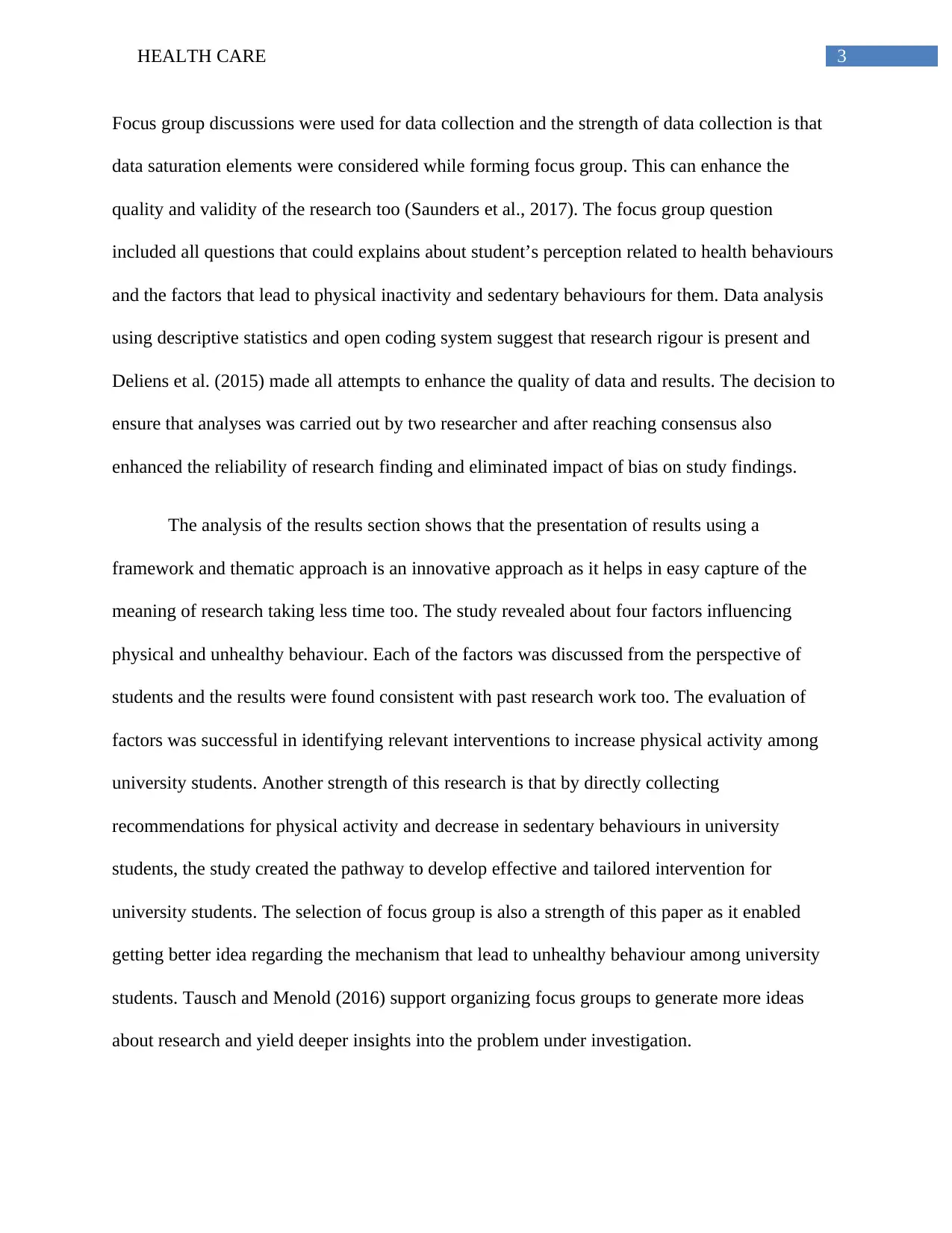
3HEALTH CARE
Focus group discussions were used for data collection and the strength of data collection is that
data saturation elements were considered while forming focus group. This can enhance the
quality and validity of the research too (Saunders et al., 2017). The focus group question
included all questions that could explains about student’s perception related to health behaviours
and the factors that lead to physical inactivity and sedentary behaviours for them. Data analysis
using descriptive statistics and open coding system suggest that research rigour is present and
Deliens et al. (2015) made all attempts to enhance the quality of data and results. The decision to
ensure that analyses was carried out by two researcher and after reaching consensus also
enhanced the reliability of research finding and eliminated impact of bias on study findings.
The analysis of the results section shows that the presentation of results using a
framework and thematic approach is an innovative approach as it helps in easy capture of the
meaning of research taking less time too. The study revealed about four factors influencing
physical and unhealthy behaviour. Each of the factors was discussed from the perspective of
students and the results were found consistent with past research work too. The evaluation of
factors was successful in identifying relevant interventions to increase physical activity among
university students. Another strength of this research is that by directly collecting
recommendations for physical activity and decrease in sedentary behaviours in university
students, the study created the pathway to develop effective and tailored intervention for
university students. The selection of focus group is also a strength of this paper as it enabled
getting better idea regarding the mechanism that lead to unhealthy behaviour among university
students. Tausch and Menold (2016) support organizing focus groups to generate more ideas
about research and yield deeper insights into the problem under investigation.
Focus group discussions were used for data collection and the strength of data collection is that
data saturation elements were considered while forming focus group. This can enhance the
quality and validity of the research too (Saunders et al., 2017). The focus group question
included all questions that could explains about student’s perception related to health behaviours
and the factors that lead to physical inactivity and sedentary behaviours for them. Data analysis
using descriptive statistics and open coding system suggest that research rigour is present and
Deliens et al. (2015) made all attempts to enhance the quality of data and results. The decision to
ensure that analyses was carried out by two researcher and after reaching consensus also
enhanced the reliability of research finding and eliminated impact of bias on study findings.
The analysis of the results section shows that the presentation of results using a
framework and thematic approach is an innovative approach as it helps in easy capture of the
meaning of research taking less time too. The study revealed about four factors influencing
physical and unhealthy behaviour. Each of the factors was discussed from the perspective of
students and the results were found consistent with past research work too. The evaluation of
factors was successful in identifying relevant interventions to increase physical activity among
university students. Another strength of this research is that by directly collecting
recommendations for physical activity and decrease in sedentary behaviours in university
students, the study created the pathway to develop effective and tailored intervention for
university students. The selection of focus group is also a strength of this paper as it enabled
getting better idea regarding the mechanism that lead to unhealthy behaviour among university
students. Tausch and Menold (2016) support organizing focus groups to generate more ideas
about research and yield deeper insights into the problem under investigation.
Paraphrase This Document
Need a fresh take? Get an instant paraphrase of this document with our AI Paraphraser
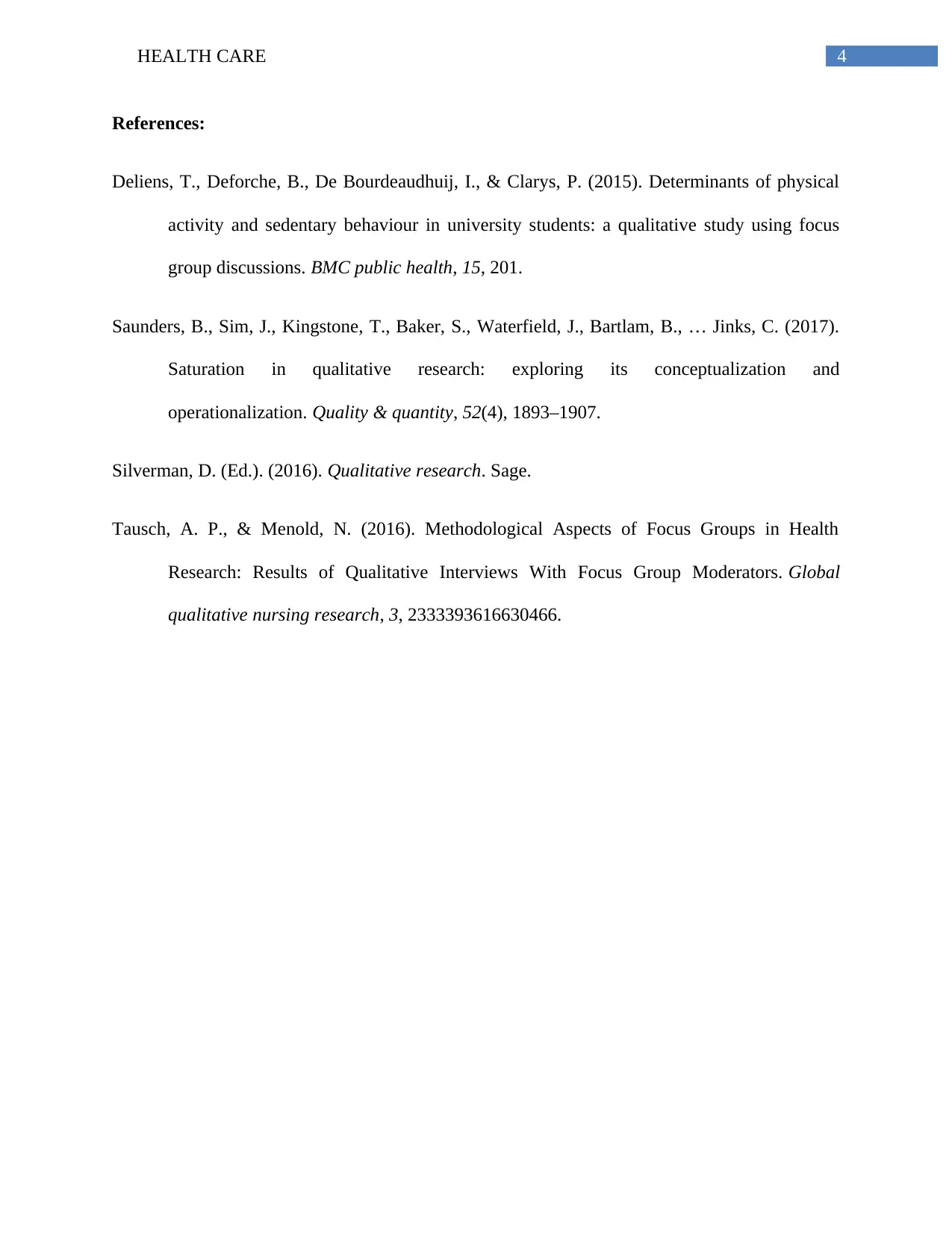
4HEALTH CARE
References:
Deliens, T., Deforche, B., De Bourdeaudhuij, I., & Clarys, P. (2015). Determinants of physical
activity and sedentary behaviour in university students: a qualitative study using focus
group discussions. BMC public health, 15, 201.
Saunders, B., Sim, J., Kingstone, T., Baker, S., Waterfield, J., Bartlam, B., … Jinks, C. (2017).
Saturation in qualitative research: exploring its conceptualization and
operationalization. Quality & quantity, 52(4), 1893–1907.
Silverman, D. (Ed.). (2016). Qualitative research. Sage.
Tausch, A. P., & Menold, N. (2016). Methodological Aspects of Focus Groups in Health
Research: Results of Qualitative Interviews With Focus Group Moderators. Global
qualitative nursing research, 3, 2333393616630466.
References:
Deliens, T., Deforche, B., De Bourdeaudhuij, I., & Clarys, P. (2015). Determinants of physical
activity and sedentary behaviour in university students: a qualitative study using focus
group discussions. BMC public health, 15, 201.
Saunders, B., Sim, J., Kingstone, T., Baker, S., Waterfield, J., Bartlam, B., … Jinks, C. (2017).
Saturation in qualitative research: exploring its conceptualization and
operationalization. Quality & quantity, 52(4), 1893–1907.
Silverman, D. (Ed.). (2016). Qualitative research. Sage.
Tausch, A. P., & Menold, N. (2016). Methodological Aspects of Focus Groups in Health
Research: Results of Qualitative Interviews With Focus Group Moderators. Global
qualitative nursing research, 3, 2333393616630466.
1 out of 5
![[object Object]](/_next/static/media/star-bottom.7253800d.svg)





